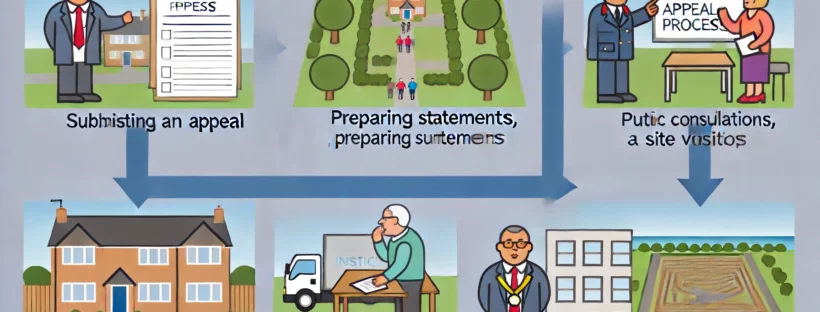The planning application appeal process allows applicants to challenge a local planning authority’s (LPA) decision to refuse planning permission, impose conditions, or fail to make a decision within the statutory period. Here’s a detailed breakdown of the process:
- Refusal of Planning Permission: The LPA has refused the application.
- Imposition of Conditions: The applicant disagrees with conditions imposed by the LPA.
- Non-Determination: The LPA has not made a decision within the statutory time frame (8 weeks for minor applications, 13 weeks for major applications).
- Time Limits: Appeals must be submitted within a specific time frame from the date of the LPA’s decision or the expiration of the decision period.
- Refusal/Conditions: Usually within 6 months of the decision.
- Non-Determination: Within 6 months of the decision period expiration.
- Appeal Form: Complete and submit the appeal form to the Planning Inspectorate.
- Supporting Documents: Include all relevant documents, such as the original planning application, decision notice (if applicable), site plans, and any additional evidence or statements.
- Written Representations: The most common and straightforward method. Both the appellant and the LPA submit written statements, and an inspector visits the site.
- Hearing: An informal discussion led by an inspector, involving the appellant, LPA, and any interested parties. It is less formal than a public inquiry but allows for verbal representations.
- Public Inquiry: A formal procedure resembling a court hearing, where evidence is presented, witnesses are cross-examined, and legal representatives may be involved. It is used for more complex or controversial cases.
- Initial Check: The Planning Inspectorate checks if the appeal form is complete and valid.
- Acknowledgment: The appellant receives an acknowledgment letter, and the appeal details are published online.
- Appellant’s Statement: The appellant submits a detailed statement explaining why the appeal should be allowed.
- LPA’s Statement: The LPA submits a statement defending its decision.
- Interested Parties: Neighbours, community groups, and other stakeholders can submit their comments or representations.
- Inspector’s Visit: An inspector visits the site to understand the context and assess the physical characteristics of the site and its surroundings.
- Unaccompanied or Accompanied: The visit can be unaccompanied or accompanied by the appellant and LPA representatives.
- Review of Evidence: The inspector reviews all submitted documents, representations, and findings from the site visit.
- Decision: The inspector makes a decision to allow or dismiss the appeal based on planning merits and relevant policies.
- Decision Notice: A formal decision notice is issued, providing reasons for the decision.
- Implementation: If the appeal is allowed, the planning permission is granted, subject to any conditions specified by the inspector.
- Further Appeals: If the appeal is dismissed, the appellant can challenge the decision in the High Court on a point of law.
Key Considerations
- Planning Policy Compliance: Appeals are assessed based on compliance with local and national planning policies.
- Material Considerations: Inspectors consider all material planning considerations, including impacts on the environment, traffic, and community.
- Transparency: The appeal process is transparent, with documents and decisions published online.
Conclusion
The planning application appeal process provides a mechanism for applicants to challenge LPA decisions. It involves submitting an appeal, choosing an appropriate procedure, presenting evidence, and receiving a decision from an independent inspector. Understanding this process is crucial for effectively navigating planning disputes.
